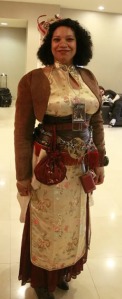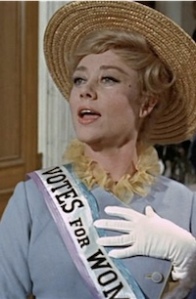Steampunk might seem to be the last genre to ever be eco-friendly, but it only seems that way if you confuse the Postmodern genre of Steampunk with the historical reality of the Industrial Revolution. They are not the same, particularly in their underlying philosophies. The Industrial Revolution was powered by Capitalism; Steampunk is all about recycling, upcycling, repurposing, sharing, reusing, valourizing Science for its achievements and not for what it can do for the profit margins. This holds true for the Aesthetic, the alternative lifestyle, and for the literary genre.
With the Steampunk Aesthetic, cosplayers take pride in making a lot of their own kit. I know that, even as the world’s slowest sewer, I have made my own items of my Steampunk wardrobe. My friends and I raid op shops looking for suitable items to be made over into Steampunk fashions. We almost make a competition of who can find the best second-hand items, and who can make the best outfit. It just isn’t environmentally friendly, or pennywise, it is also a lot of fun. In fact, we make our costumes because of any idealistic values, but because we achieve an unique style by making our own costumes.

My hand-decorated hat and recycled vest.
This is the case for my community. We have swap meets, workshops, ops shop adventure days and other events. We make quite a few of our own gadgets, including my lovely backpack that Matt the Tinkerer built (with some help from me).

Backpack designed and made by Matt the Tinkerer.
This has all been a longwinded introduction to the concept of Steampunk Mash-ups. I love a good mash-up, I really do, be it a cosplayer dressed as Steampunk Batman, a group of Steampunk Ghostbusters (I am a member of such a group), or a story that borrows settings, characters, and situations from other literary sources. The most famous example would be The League of Extraordinary Gentlemen, which borrows something from just about every well-known Victorian novel.
One of the literary markers of the Steampunk genre is this use of well known individuals, both real life people and literary characters. This is a very Postmodern strategy, incorporating the old and traditional into the new, to create something that exceeds the impact of both as single entities. A mash-up can add a depth to the story that wouldn’t be achieved otherwise.
The series by Michael Pryor, The Extraordinaires, has Rudyard Kipling as a character. Kipling’s Junglebook is the jumping off point for the series, as this series also explores what defines civilisation and what defines the ‘Other’. So Kipling isn’t just a character, his work supplied the inspiration for the other characters and the plots, and so he acts as an analogy and as an allegory within the story. Masterful stuff!

One of the books in The Extraordinaires series by Michael Pryor.
It is fitting that the Steampunk literary genre ‘recycles’ other literary works in this manner. Most of the literature from the Victorian era is no longer in copyright, and can be used safely without stepping on anyone’s toes. You can use quite famous characters and real historical people, like Dracula or Brunel, and really go to town with them. Or you could research obscure Victorian characters to use in your stories. I like to research scientists, myself.
So don’t be frightened to try a mash-up. Not only is it fun, but it is in the finest tradition of the Steampunk literary genre.




















